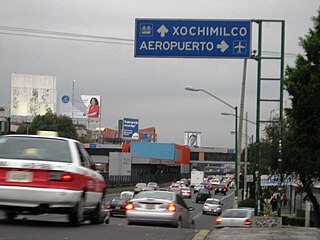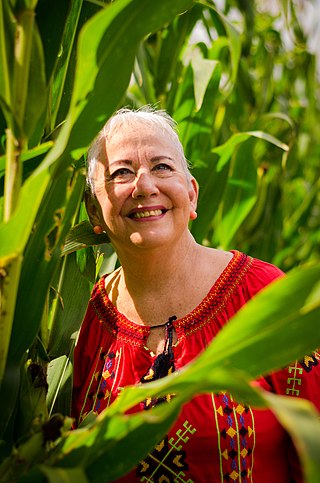
The vaquita is a species of porpoise endemic to the northern end of the Gulf of California in Baja California, Mexico. Reaching a maximum body length of 150 cm (4.9 ft) (females) or 140 cm (4.6 ft) (males), it is the smallest of all living cetaceans.

The Fashion and Textile Museum is an English museum.
The year 2003 in architecture involved some significant architectural events and new buildings.

The Ibero-American University, also referred to by its acronym UIA but commonly known as Ibero or La Ibero, is a private, Catholic, Mexican higher education institution, sponsored by the Mexican province of the Society of Jesus (Jesuit). In 2009, the UIA received the SEP-ANUIES Prize as the best private university in Mexico. The Ibero's flagship campus is located in the Santa Fe district of Mexico City.

Viaducto is a station on Line 2 of the Mexico City Metro system. It is located in the border of Benito Juárez and Iztacalco boroughs of Mexico City, south of the city centre on Calzada de Tlalpan. It is a surface station.
Ricardo Legorreta Vilchis was a Mexican architect. He was a prolific designer of private houses, public buildings and master plans in Mexico, the United States and some other countries.

The Angel of Independence, most commonly known by the shortened name El Ángel and officially known as Monumento a la Independencia, is a victory column on a roundabout on the major thoroughfare of Paseo de la Reforma in downtown Mexico City.
The San Antonio Public Library (SAPL) is the public library system serving the city of San Antonio, Texas. It consists of a central library, 29 branch libraries, and a library portal. SAPL was awarded the National Medal for Museum and Library Service in 2006.

Mi Destino Eres Tú is a Mexican telenovela produced by Carla Estrada for Televisa that premiered on July 10, 2000 and ended on November 10, 2000. It is an original story by Carmen Daniels and Jorge Lozano Soriano. Lucero sang the theme song of the series, being released in the album Mi destino. It stars Lucero, Jorge Salinas, Susana Zabaleta and Jaime Camil.
The architecture of the U.S. state of Texas comes from a wide variety of sources. Many of the state's buildings reflect Texas' Spanish and Mexican roots; in addition, there is considerable influence from mostly the American South as well as the Southwest. Rapid economic growth since the mid twentieth century has led to a wide variety of contemporary architectural buildings.

Viaducto Miguel Alemán is a crosstown freeway, opened in September 1950, that runs east-west across central Mexico City. In the center of the road is a river encased in cement to control flooding. Metro Viaducto is named after this road.

The Anillo Periférico known by locals as el periférico is the outer beltway of Mexico City.
The year 2011 in architecture involved some significant architectural events and new buildings.

Luis Ramiro Barragán Morfín was a Mexican architect and engineer. His work has influenced contemporary architects visually and conceptually. Barragán's buildings are frequently visited by international students and professors of architecture. He studied as an engineer in his home town, while undertaking the entirety of additional coursework to obtain the title of architect.
Jesús Reyes Ferreira, (1880-1977) born José de Jesús Benjamín Buenaventura de los Reyes y Ferreira and also known as Chucho Reyes, was a self-taught artist and antiques/art collector and vendor. Reyes Ferreira began painting on crêpe paper, a delicate material not meant to last, as a way of decorating paper meant to wrap sales from his antiques/art store. The decorated paper became popular enough to be sold on its own. Although he began this activity in Guadalajara, he did not produce the bulk of his work until after he moved to Mexico City when he was 58 years old. Here he continued collecting and selling objects such as colonial art and Mexican handcrafts and folk art, being one of the early exponents for the appreciation of these objects. He also spent several hours a day painting. His work was first exhibited in 1950 with his first individual exhibition in 1967 at the Palacio de Bellas Artes after a half century of painting. As a self-taught painter, his works are relatively simple and often are dismissed as folk painting but they were and his aesthetics were praised by famous artists and architects at the time.

The Torre BBVA México is an office skyscraper on Paseo de la Reforma in Colonia Juárez, Mexico City. It is the headquarters of BBVA México, Mexico's largest bank. Upon its completion in 2015 it became the second tallest building in Mexico City at 235 metres (771 ft) and 50 stories high. However by 2018 it is expected to be the fourth tallest in Mexico, after Torre KOI, Torre Reforma and Punto Chapultepec.
Víctor Legorreta Hernández is a Mexican architect, son of the architect Ricardo Legorreta Vilchis.
Legorreta is a surname found in Mexico. Notable people with the surname include:

Enriqueta Medellín was a Mexican surgeon and environmentalist. Raised in Mexico City, from a young age she participated in projects to clean up the city and became interested in the links between disease and the environment. She earned a degree as a medical surgeon from the National Autonomous University of Mexico and specialized in human genetics. She also studied environmental education and management.

Enriqueta Legorreta was a Mexican soprano and activist. She grew up in Mexico City and studied opera at the Conservatorio Nacional de Música. Debuting in 1941, she earned praise for her portrayal of Sieglinde in Wagner's Die Walküre and was noted as the first Mexican woman to sing a Wagnerian opera. She was one of the pioneering singers who joined and performed in the inaugural season of the Ópera Nacional, performing Leonora in Beethoven's Fidelio in 1943. During her career, which lasted into the mid-1970s, she sang with many well-known conductors and musicians, including Claudio Arrau, Leonard Bernstein, Pablo Casals, Igor Stravinsky, and Isaac Stern. She was also involved in protests against the opera association to ensure that singers were paid for their professional work, rather than their affiliations with officials.











